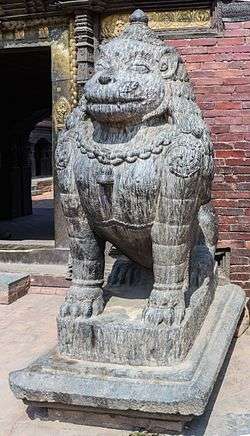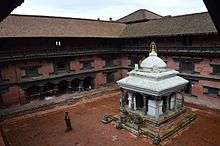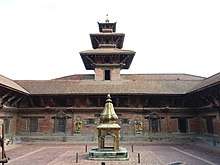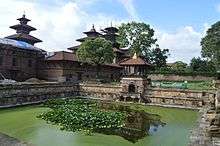Patan Durbar Square
Patan Durbar Square is situated at the centre of the city of Lalitpur in Nepal. It is one of the three Durbar Squares in the Kathmandu Valley, all of which are UNESCO World Heritage Sites. One of its attraction is the ancient royal palace where the Malla Kings of Lalitpur resided.
The Durbar Square is a marvel of Newar architecture. The Square floor is tiled with red bricks.[1] There are many temples and idols in the area. The main temples are aligned opposite of the western face of the palace.[2] The entrance of the temples faces east, towards the palace. There is also a bell situated in the alignment beside the main temples.[3] The Square also holds old Newari residential houses. There are various other temples and structures in and around Patan Durbar Square built by the Newa People.
The square was heavily damaged by the earthquake in April 2015.[4][5]

History
The history of the Durbar Square is not clear. Although the Malla Kings of Lalitpur are credited with the establishment of the royal square, it is known that the site is an ancient crossroad. The Pradhanas who settled around the site before the Mallas have connections with the Durbar Square.[1] Some chronicles hint that the history of Patan Thakuri Dynasty built a palace and made reforms to the locality but the evidence is minute. Scholars are certain that Patan was a prosperous city since ancient times.[6]
The Malla Kings did make important changes to the square. Most of the current architecture is from the 1600s, constructed during the reign of King Siddhi Narsingh Malla and his son Srinivasa Sukriti. Some of the notable Malla Kings who improved the square include Purandarasimha, Sivasimha Malla and Yoganarendra Malla.[1][6]
Important buildings

Patan is one of the oldest known Buddhist cities. It is a center of both Hinduism and Buddhism with 136 bahals or courtyards and 55 major temples.[7] Most of these structures are in the vicinity of the Durbar Square.
Krishna Mandir
Krishna temple is the most important temple in Patan Durbar Square.[8] It is built in the Shikhara style imported from India although it is unique in its own way. The stone carvings along the beam above the first and second-floor pillar are most notable. The first floor pillar carvings narrate the events of the Mahabharata, while on the second floor there are visual carvings from Ramayana.[8][9]
The temple was built in 1637 by King Siddhi Narsingh Malla. It is said that one night the King saw Lord Krishna and his consort Srimati Radha standing in front of the royal palace. He ordered a temple to be built on the same spot.[10] There are 21 golden pinnacles in the temple. Below the pinnacles are 3 stories. The first floor holds the main shrine of Lord Krishna with shrines of Radha and Rukmini at each side. The second floor is dedicated to Lord Shiva and the third to Lokeshwor (Lord Buddha).[1][10]
The square is crowded with thousands of Hindu Pilgrims and devotees during Krishnastami.[11]
Bhimsen Temple

Bhimsen temple was built by Srinivasa Malla in 1680. It is renowned for its three interconnected golden windows. Bhimsen is a great personality in Mahabharata. He was known to be very brave and strong. In Newa: Tradition, he is worshiped as a god of business and trade.[1][12] Tourists are not allowed inside the temple.[13]
Vishwanath Temple
Vishwanath temple is dedicated to God Shiva. It was built in 1627 during the reign of Siddhi Narsingh Malla. The roof supports are decorated with erotic carvings similar to imagery widespread in Shiva temples in India. The temple is guarded by two stone elephants in the front entrance. On the other side of the temple is the sculpture of a bull, Shiva’s vehicle. A stone linga is enshrined inside the temple.[1][14][15]
Taleju Bhawani Temple
Taleju temple was built by Siddhi Narsingh Malla in 1640 and rebuilt by Srinivasa Malla in 1667 after a fire. Taleju Bhawani was the personal deity of the Malla kings. It is a five-storey temple with triple-roofs.[16] 14th Century chronicle of Gopala kings hint a Taleju temple was built by the Pradhanas before the Mallas.[1]
Layout of the Palace
The three main courtyards in the palace are Mul Chok, Sundari Chok and Keshav Narayan Chok. Besides these courtyards, the complex boasts impressive temples, religious shrines, and historical places, all noted for their exquisite carvings and beautiful display of ancient Newari architecture.[2] [17] [18]
Keshav Narayan Chowk

Keshav Narayan Chowk is, inside the Patan Museum, to the north of the Mul Chowk. At the center of this chowk, Keshav Narayan Temple is located which gave the name to this chowk.
Mul Chok

1.jpg)

Mul Chok is the central courtyard. It is the most famous and largest courtyards among the three main chowks. At its center is located Vidya Temple, and Taleju temples stand around the courtyard. The doorway to the Shrine of Taleju, on the southern side of the courtyard, is confined by the statues of the river goddesses Ganga, on a tortoise, and Jamuna, on a carved makura (mythical crocodile).[19]
Sundari Chok

Sundari Chok is to the south of the Mul Chok. It is designed with sunken tank known as Tusha Hiti. Smaller than the Mul Chok, it is now open to the public. The entrance of the chowk is guarded by the stone statues of Hanuman, Ganesh and Narasingha, man-lion form of Vishnu[20]
Inside the Patan Durbar Square Photo gallery

 Bhandarkhal Garden and water tank
Bhandarkhal Garden and water tank Under construction during renovation of Patan Durbar Square
Under construction during renovation of Patan Durbar Square
 A agriculture stone sculpture inside the Patan Durbar Square
A agriculture stone sculpture inside the Patan Durbar Square








References
- 1 2 3 4 5 6 7 Pallav Ranjan (2007). "Patan Durbar Square". Spiny Babbler. Archived from the original on 2009-08-22. Retrieved 2013-04-22.
- 1 2 "SAARC Tourism Nepal -- Patan Durbar Square".
- ↑ "Nepalopedia". Retrieved 2013-04-22.
- ↑ https://twitter.com/SnowdenJohn/status/591857002239766528/photo/1
- ↑ "Earthquake in Nepal: Patan Durbar Square shattered completely". India.com, online. Retrieved 2015-04-25.
- 1 2 "Patan". Department of Archaeology, Nepal. Retrieved 2013-04-22.
- ↑ "Patan Durbar Square". Nepal and Beyond. Archived from the original on 2013-06-30.
- 1 2 "Patan Krishna Temple".
- ↑ "Krishna Mandir".
- 1 2 "Krishna Mandir Temple".
- ↑ "Krishnastami". World Press.
- ↑ "Bhimsen Temple".
- ↑ "View of Bhimsen Temple".
- ↑ "Vishwanath Temple, Patan".
- ↑ "Vishwanath Temple".
- ↑ "Taleju Temple".
- ↑ "Google Sketchup 3D model of Patan Durbar Square".
- ↑ "Google Sketchup 4D model of Patan Durbar Square".
- ↑ "Mul Chowk".
- ↑ "Sundari Chok".
Coordinates: 27°40′23.04″N 85°19′32.57″E / 27.6730667°N 85.3257139°E
